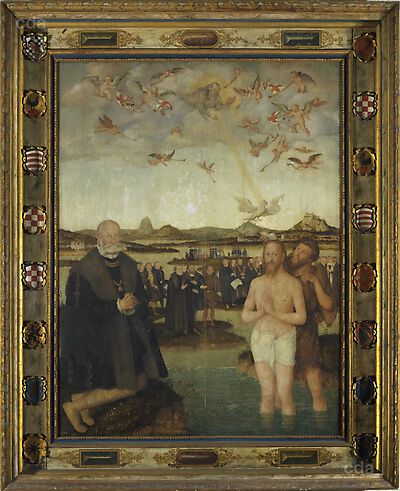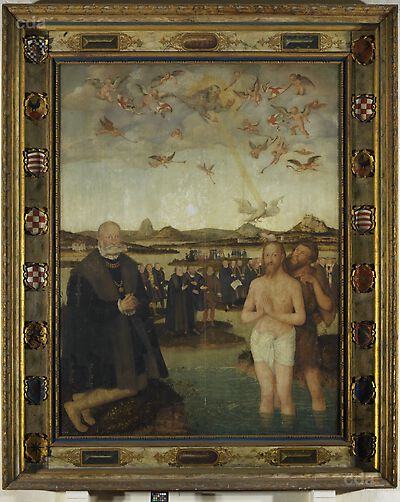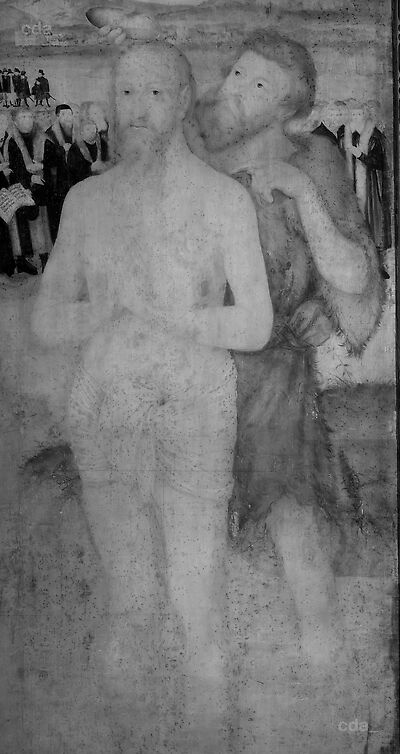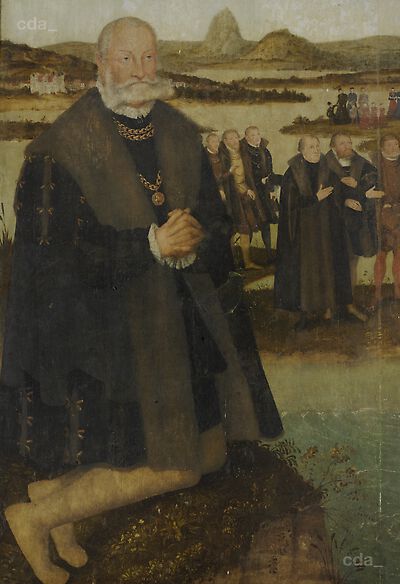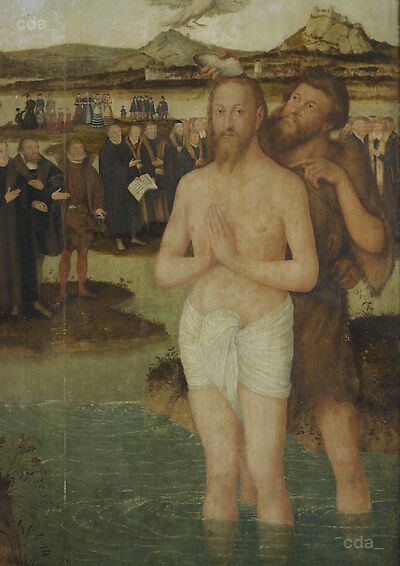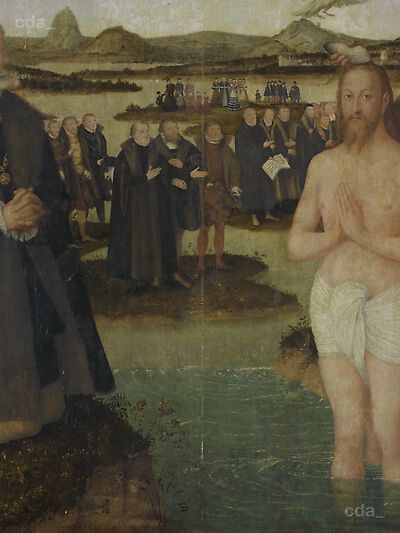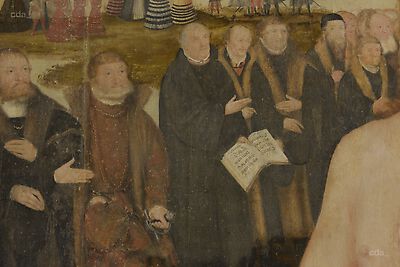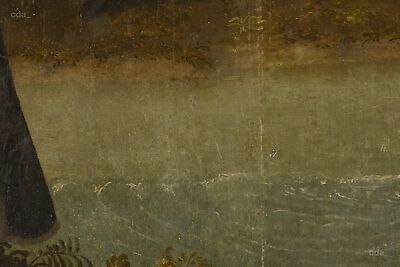The painted epitaph depicts the Baptism of Christ in the river Jordan. Standing at the right edge of the painting is Christ wearing a loincloth, looking directly at the viewer and holding his hands in an attitude of prayer. St John the Baptist stands behind in the river. He wears
The painted epitaph depicts the Baptism of Christ in the river Jordan. Standing at the right edge of the painting is Christ wearing a loincloth, looking directly at the viewer and holding his hands in an attitude of prayer. St John the Baptist stands behind in the river. He wears the typical fur robe and is identified by his considerably darker skin. St John has scooped up a bowl of water from the Jordan and pours it over Christ's head. The Holy Ghost, who has been sent by God the Father from an auriole framed by clouds, hovers over Christ in the shape of a dove. A large number of angels with trombones enliven the clear sky.
The deceased (1566) Duke Wolfgang of Anhalt, to whom this epitaph is dedicated, kneels in the left corner close to the edge of the painting and opposite the baptism scene. He wears a splendid fur-trimmed coat over a black robe as well as a triple chained gold necklace with a portrait medallion bearing an inscription. His grey beard is cut straight across beneath the chin.
Isolated figurative groups have gathered on different islands in the background landscape. Between Wolfgang and the Baptist male representatives of the Anhalt family are visible, in the first row Wolfgang's cousin Georg III., Johann IV. and Joachim I., the sons of Johann IV appear to be represented behind to the left. Joachim Ernst of Anhalt can be identified in the centre, possibly flanked by his brothers Karl and Bernhard VII.
Behind the baptism scene in the middle-ground is a large group of reformers and scholars, in the front Luther and Melanchthon. Johann Forster can also be identified in this group.
Finally in the background women and children are depicted who probably represent members of the Anhalt house and their more distant relatives. A veduta is visible on the horizon, which appears to be a representation of Wittenberg.
[Görres, cda 2015]
- Attribution
- Lucas Cranach the Younger
Attribution
| Lucas Cranach the Younger | [Schade 1974, 96] |
- Production date
- 1568
Production date
| 1568 | [dated] |
- Dimensions
- Dimensions of visible surface 274 x 203.5 cm
Dimensions
Dimensions of visible surface 274 x 203.5 cm
Dimensions including frame: 347 x 276.5 x 23 cm
[Heydenreich, cda 2015]
- Signature / Dating
Artist's insignia and date at the bottom left: serpent with dropped wings, facing right, and dated '1568'; in yellow paint
Signature / Dating
Artist's insignia and date at the bottom left: serpent with dropped wings, facing right, and dated '1568'; in yellow paint
[cda 2015]
- Inscriptions and Labels
In the middle-ground Luther holds an open book with the following text:
-
The title extends over both pages:
'Matth. III …Inscriptions and Labels
Inscriptions, Badges:
In the middle-ground Luther holds an open book with the following text:
- The title extends over both pages:
'Matth. III Xvi[?]'
- left page:
'Diess ist
mein liber
Son, an wel=
chem ich ein'
- right page:
'wolgefalle
habe, den
sollet ihr
hören.'
[Görres, cda 2015]
- inscription (after [Wieman 1907, 69f.]):
Piis manib.
Illustriss. Pr. ac Dn. D. Guolphgangi Dei Gr. Pr. Anhalt. Com.
Ascaniae Dn. Servestae et Bernburgi etc., qui Servestae pie de-
functus est anno Christi MDLXVI Martii D. XXIII. H. noct. XI.
Min. XLV. cumque magno familiae patriaeque luctu sepultus,
mensis eiusdem D. XXVII. H. X., aetatis anno LXXIIII currente,
In hoc choro, quem una cum templi parte contigua quae est inter
portas austral. et bor. ope sua fecit instaurari placidam.
Princeps Anhaltinae domus
Guolphgangus Ascaniae comes
Servesta quem dominum suum
Et Berneburga norat: O Patriae pater
Cui cura prima erat Deus, Temp. M.
Tutela legum proxima, D.
Salus quiritum tertia, H.
Postrema habiri asilum pauperum fuit. M.
Ardens amore coelitum, Aet. Pr.
Regnique particeps sui, An. Chris
Gnate o Dei vitae satur, ti
Fide supremam clausit hic firma diem Mundi
Senum sub hoste Martio,
Vicena lux et tertia,
Nonamque post hora altera
Punctumque fluxerat quadrantis ultimi.
Guolphgange vixisti pie,
O pax Anhaltinae domus.
Sepulte dormias senex,
Tristata sunt ob cuncta principem suum.
Patruo magno et parentis loco habito,
Nepp. et heredes Joachimus Ernestus et
Bernhardus FFr. Et PPr. Anhalt. moesti H. M. F. FF.
- Owner
- Evangelische Kirchengemeinde St. Bartholomäi, Zerbst
- Repository
- Evangelische Kirchengemeinde St. Bartholomäi, Zerbst
- Location
- Zerbst
- CDA ID
- DE_KBZ_NONE-KBZ001
- FR (1978) Nr.
- FR-none
- Persistent Link
- https://lucascranach.org/en/DE_KBZ_NONE-KBZ001/
-
